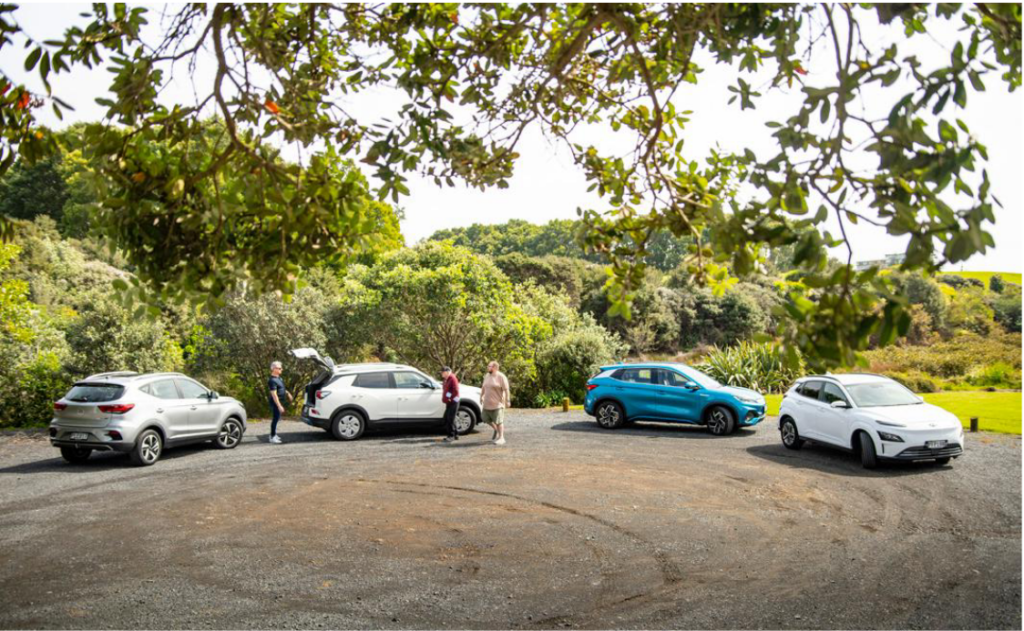
Compact electric SUVs have become the latest battleground for fleet buyers, so FleetTalk gathered four contenders from BYD, Hyundai, MG and SsangYong for a group evaluation.
Few electric cars have attracted as much discussion in 2022 as the BYD.
Not only is it a new model, but BYD is an all-new brand in the market, arriving amid rising consumer demand for Chinese-built vehicles.
And Chinese brand MG has given its first all-electric contender, the ZS EV, a spruce-up with more range, more tech, and better looks. And it’s still the cheapest way to get into a new electric car.
So, we decided to put the Chinese newcomers up against rival electric crossover SUVs from Korea, established star the Hyundai Kona Electric and new arrival the SsangYong Korando E=motion.
The numbers
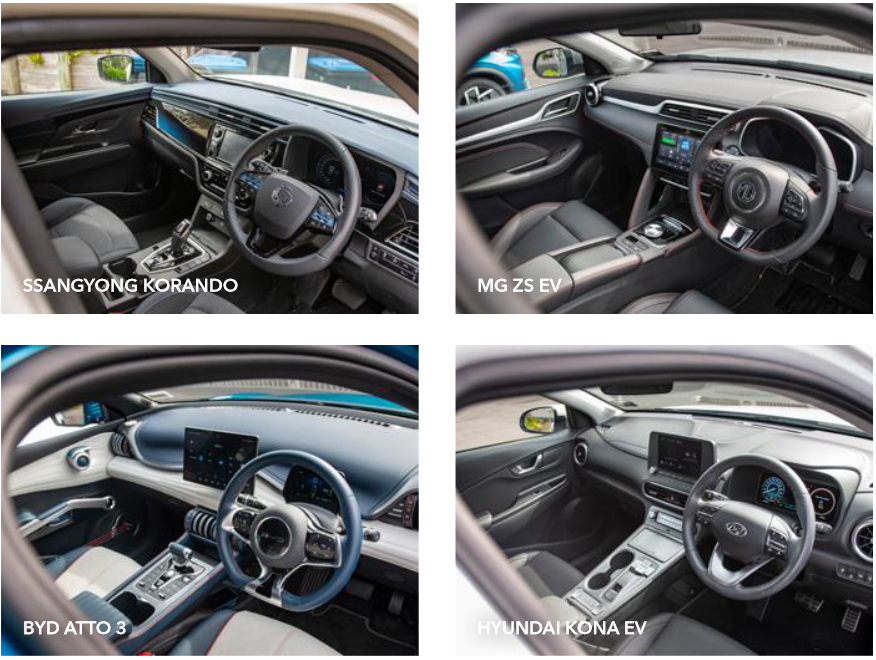
There is plenty to consider in terms of prices and battery sizes.
The new MG is more of an evolution than a revolution. Though Kiwis miss out on the bigger battery offered overseas, the 51kWh unit we get is an upgrade.
Range expectation gets bumped from 263km to 320km, and it also provides vehicle to load (or V2L) charging.
The flagship Essence pictured here is $53,990, meaning an outright price in the mid-40k bracket after factoring in on-road costs and the Clean Car Discount.
The Korando is a curiosity in this field, thanks in part to a lack of fanfare prior to its pricing announcement.
Just one Korando spec offered in New Zealand, priced at $59,990 plus on-roads.
Though its 61.5kWh battery (SsangYong quotes 340km of range) is fairly impressive, the Korando’s real secret weapon is its size.
Packing around 140mm extra length and 60mm extra width over the MG, it’s effectively boxing in a completely different weight division. As a big added bonus, it’s rated to tow 1500kg.
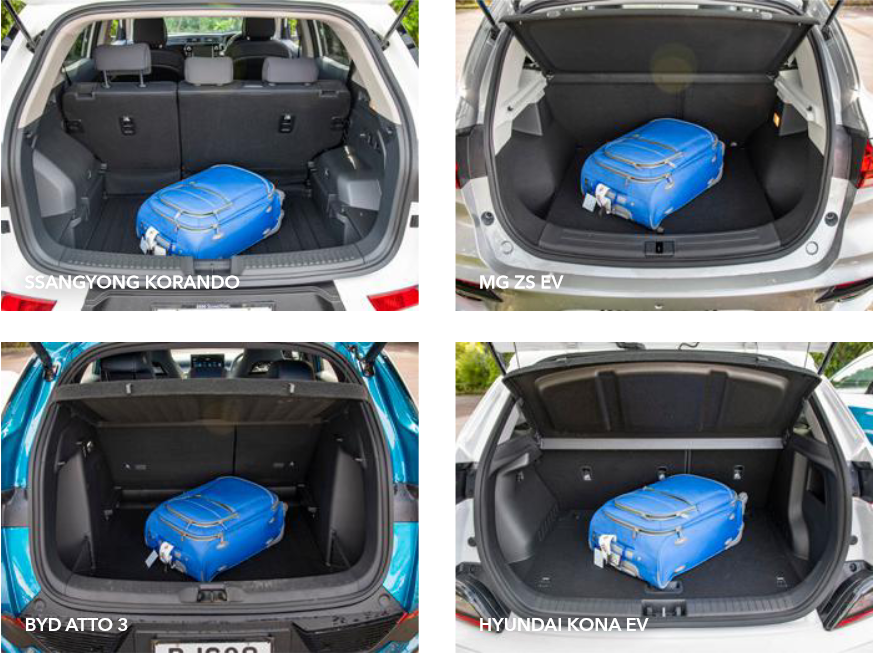
Since its arrival, BYD’s Atto 3 has been a sales sensation, stacking orders with a frequency likely to scare Tesla.
The line-up is clever. BYD offers two trim levels loaded with equipment, with the only difference being battery size.
Our test 60kWh model is the flagship, and supposedly can travel up to 420km and still sell for well under 60 grand.
Updated last year, the Kona is arguably the only household name in this group. Though we’d hoped to test the entry-level 39.2kWh model, we ended up with the equivalent big battery 64kWh version.
That mean enormous range (484km claimed) and a hefty pricetag. Priced at $79,990, this Kona only just manages to qualify for an EV rebate while also being a potentially awkward bedfellow for the identically priced entry-level Ioniq 5.
Outside
The desire for EVs that look normal while conveying a “hey, look at me, I’m the future” message is a tightrope for carmakers.
The BYD probably strikes the balance best out of this group. Its handsomely rounded nose is complemented by a tasteful array of silver and chrome jewellery and some suitably futuristic (and aerodynamically friendly) wheels.
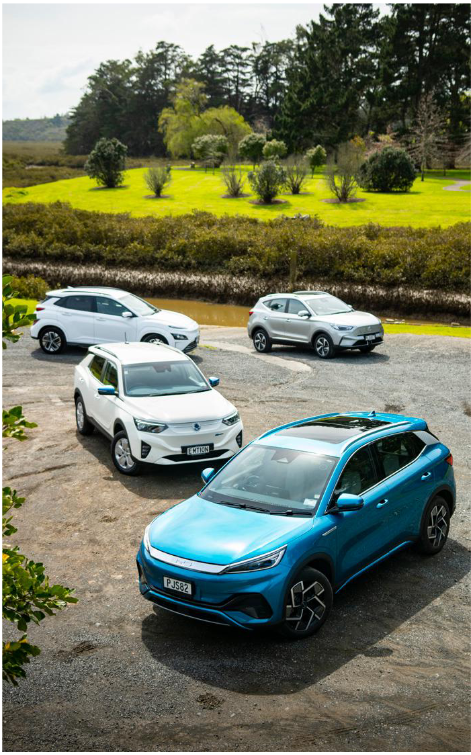
The bold Build Your Dreams text on the bootlid is an acquired taste, but can be removed easily.
The Hyundai and MG facelifts do well to distance each model from its internal combustion cousins.
The old ZS EV seemed to have something of an identity crisis, borrowing the petrol model’s grille as if it was too shy to show its true EV self to the world.
There’s little mistaking one for the other now, though, thanks to the MG’s slick new nose.
Things are less rosy in SsangYong’s corner. The E-Motion’s reworked nose screams for some colour contrast to break up the sea of uninterrupted white.
Swapping in the wheels and front bumper from the combustion engine Korando onto the E-Motion would result in instant improvement.
In the absence of that, ordering one in a dark colour (SsangYong offers the model in a dashing dark blue) will help.
Inside
Thankfully the SsangYong is much improved inside. Being based on a model that’s already several years old means the dashboard isn’t particularly cutting edge to look at or use, although its simplicity in this company will make it attractive for potential fleet customers. A good dash for “myopic middle aged men”, said one member of our panel of testers.
The Korando’s cloth seats are very comfortable, and there’s plenty of room in both the front and the back. Rear legroom and headroom are streets ahead of everything else here, with enough space to host three adults comfortably.
The boot is enormous, too, swallowing 551 litres. Primarily, It may be an ICE platform, but there’s no compromise on space.
The BYD is almost the perfect opposite to the SsangYong. Its interior is completely out the gate
The door pockets feature a huge guitar motif, complete with red bungy cord strings. The door handles operate by being twisted instead of pulled.
The synthetic soft-touch panel on the dash feels as if it’s made from wet suit material. And the 12.8-inch touchscreen rotates electronically.
Although the BYD is roomy and comfortable for passengers, the boot is something of a low. Although the 440 litres BYD quotes make it the second largest in our test, its narrow shape makes it among the least practical.
The other BYD caveat is its digital interface. Though the rotating screen is fun, the software within isn’t necessarily the most intuitive to use or the best presented.
As it stands, the Atto 3 doesn’t come with any form of Android Auto or Apple CarPlay, although that is coming via an over-the-air update later in 2022.
We also found the digital cluster to be a little too small; quite the issue given the enormous amount of information it conveys to the driver.
“The Chinese vehicles are trying too hard with their digital HMI, they’re too complicated and not as intuitive or easy as the two Koreans,” noted a panel member. “[The MG’s] touchscreen interface is bigger, better and faster than before but it’s still not perfect.”
Software aside, MG has done very well to make the ZS’s cabin feel more expensive than it is by using soft-touch materials in all the right places complemented by premium
kit like the panoramic sunroof. It’s let down slightly by the low quality of its cameras.
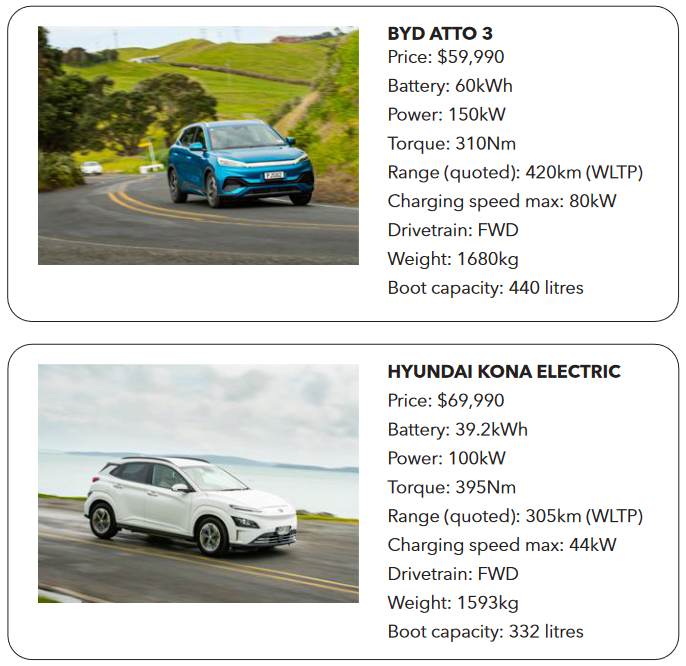
There’s little wrong with the Hyundai’s cameras. Its infotainment is arguably the most user-friendly here, even if it resides on a smaller eight-inch screen.
Its driving position is spot on, and adults will fit in the second row without any trouble. Even considering these wins, multiple judges noted that the Kona’s cabin felt dated thanks to obsessively inoffensive styling and some cheap plastics.
Hyundai has made enormous inroads with its interior design lately, so expect it to correct the Kona in its next update.
On the Road
A panel of four judges took these EVs on a drive loop starting in Auckland then snaking through Whitford and Maraetai, before returning to base via Brookby and Flat Bush.
That’s a fairly good cross section of typical Kiwi roads, ranging from motorway, to suburbia, to rural chip seal and winding beachside terrain.
On the latter, the Kona unveiled itself to be surprisingly fun to lob around. Its balanced chassis and tyre combo offers healthy grip, aided by a front end that’s keen to be directed at apexes.
The trade-off for is ride quality. The Kona is the firmest riding here by a long way, with some suggesting the ride quality would grow tiresome over a long distance.
By contrast, the BYD and SsangYong are the most comfortable and quiet, soaking up potholes (a worthy skill these days particularly) with aplomb.
Sitting somewhere in the middle was the MG, a pleasant enough drive in isolation but made to feel mechanically compromised in this company.
Naturally, all four EVs feel twice as quick off the mark as their petrol stablemates. The SsangYong and BYD are probably the punchiest while our resident ZS owner Richard Edwards believed that the MG felt a little neutered off the line when compared to his first-gen ZS.
Of course, the purpose of this drive wasn’t just to drive fast. It was also an efficiency test of sorts.
We logged the odometer readings and battery percentage levels of each car before and after the journey, giving us a theoretical economy rating for each car.
We completed the loop while driving how we suspect most Kiwis drive – air conditioning on full-blast, mostly making use of normal drive modes, and putting our foot down a little. This was no economy run.
It’s worth acknowledging from the outset that though each car has a designated battery size, there’s sometimes a discrepancy between that size and the amount that’s actually “usable”.
The Hyundai and BYD battery claims are effectively spot on in terms of available kWh, while the MG falls a few kWh short.
The SsangYong was the guiltiest party here; its 61.5kWh lump only featuring 55.3kWh of usable battery.
In spite of its aggressive regenerative braking, the E-Motion also ended up as the least efficient of the bunch, using 20.0kWh/100km and shedding 29% of its battery in the process – notching up less than 5km per kWh.
Being the biggest and heaviest vehicle here means some of that is simply to be expected. Testing it against a more equally sized EV might be a better test of its economy.
The ZS and Atto 3 were largely neck-and-neck. The pair used 26% (MG) and 23% (BYD) of their batteries respectively.
In spite of leading the MG on percentage used, the BYD still burnt more energy overall, 17.4kWh/100km to the ZS’s 15.9kWh/100km.
In kilometre terms, the BYD travelled 5.7km for each kWh, and the MG 6.2km.
By far and away the most efficient of the bunch was the Hyundai. Even with Richard, our most lead-footed tester, driving it for back-to-back stints, it used a mere 17% of its 64kWh battery, equating to 13.kWh/100km and an average of 7.3km to a kWh.
Being in its second generation, the Kona’s powertrain and battery tech is likely the most refined of the bunch, and it shows.
Verdict
The Kona claiming ownership of the most refined and economical drivetrain will surprise nobody.
Hyundai has been one of the most resolute investors in EV tech and is well on its way to being the most plug-in prepared company among its mainstream peers.
It’s hard to look past that price, when there are three other cars in this comparison with similarly sized batteries and arguably more character, priced well over 20k less.
“Buyers will need to decide whether range trumps features in their purchasing decision,” noted one judge.
The tweaks MG has made keep the ZS EV feeling fresh and competitive, even against rivals that outgun it on paper.
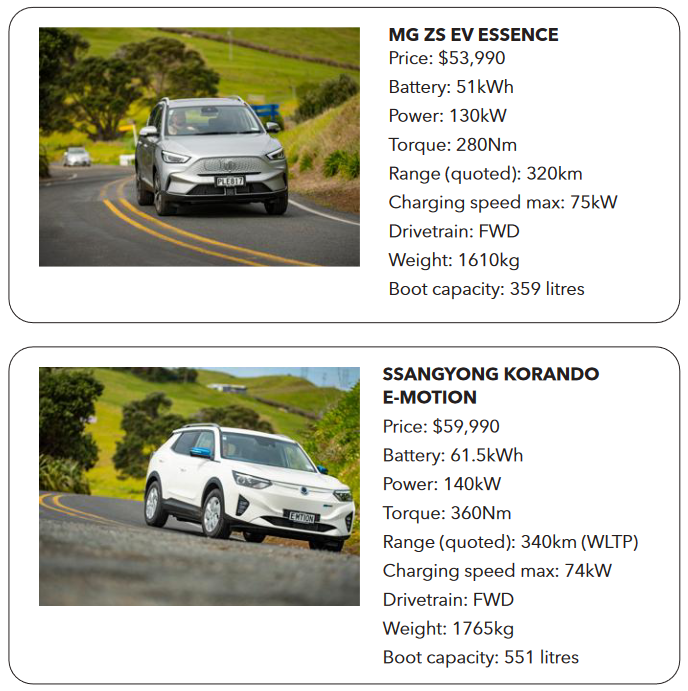
It continues to be an example of how cheap doesn’t have to mean nasty, and buyers shopping on price are going to be more than happy with it.
That just leaves the SsangYong and the BYD. The pairing feel like they’re built for opposing ends of the EV customer spectrum.
The Korand is a little like one of those mobile phones you buy for Nan with the enormous number buttons.
The BYD is like one of those newfangled folding phones for people craving the current hotness.
It’s the BYD that wins this comparo, but it does so with a surprisingly slight margin.
Handsome looks, a strong battery, competitive pricing, and the promise of improved tech down the line are all big factors.
But for all the BYD’s whistles and bells, the idea of getting a RAV4-sized EV in the form of the SsangYong for identical money is tempting indeed.
BYD Atto 3
Price: $59,990 Battery: 60kWh Power: 150kW Torque: 310Nm Range (quoted): 420km (WLTP) Charging speed max: 80kW Drivetrain: FWD Weight: 1680kg Boot capacity: 440 litres
Hyundai Kona Electric
Price: $69,990 Battery: 39.2kWh Power: 100kW Torque: 395Nm Range (quoted): 305km (WLTP) Charging speed max: 44kW Drivetrain: FWD
Weight: 1593kg Boot capacity: 332 litres
MG ZS EV Essence
Price: $53,990 Battery: 51kWh Power: 130kW Torque: 280Nm Range (quoted): 320km Charging speed max: 75kW Drivetrain: FWD Weight: 1610kg Boot capacity: 359 liotres
SsangYong Korando E-Motion
Price: $59,990 Battery: 61.5kWh Power: 140kW Torque: 360Nm Range (quoted): 340km (WLTP) Charging speed max: 74kW Drivetrain: FWD Weight: 1765kg Boot capacity: 551 litres








